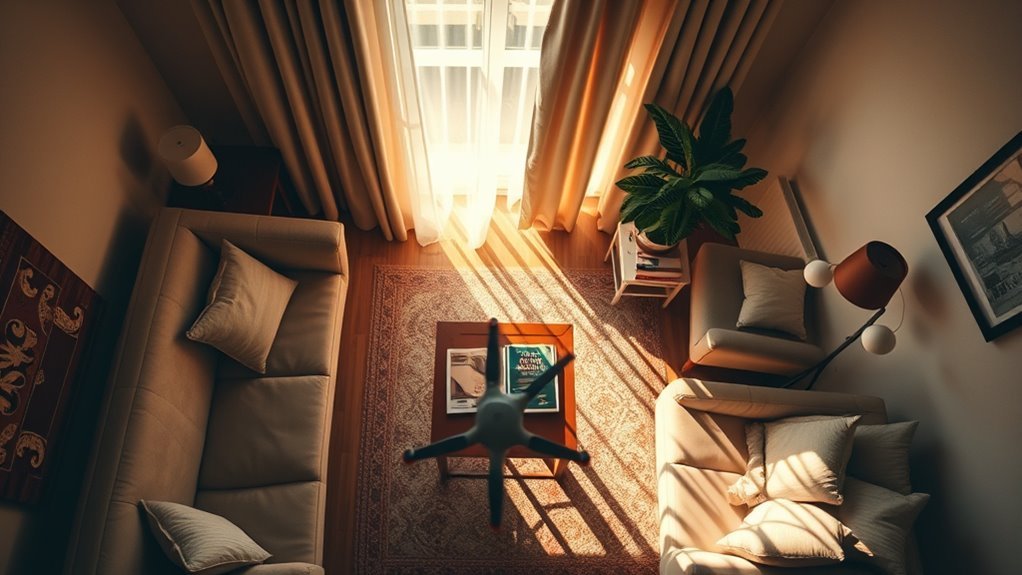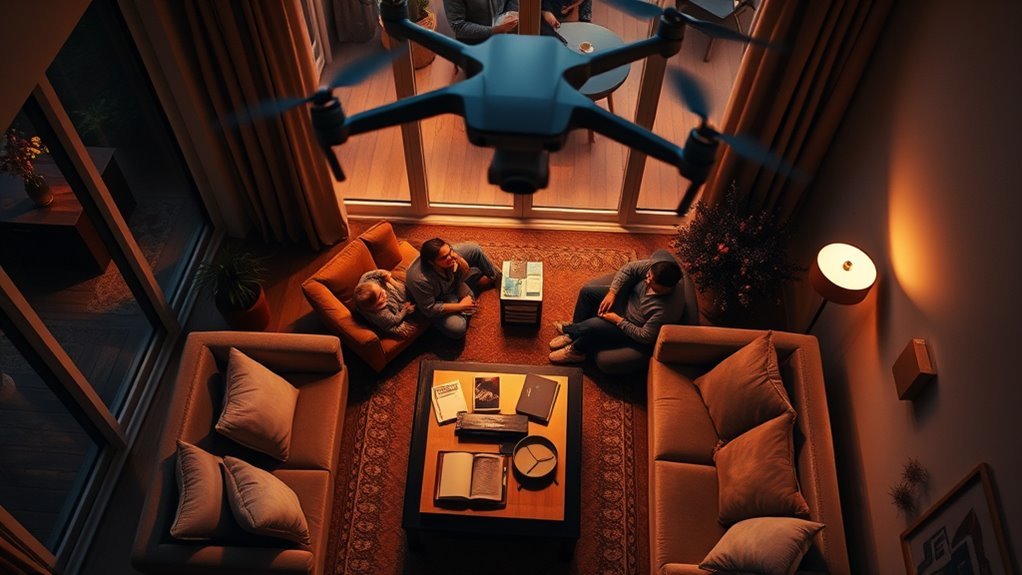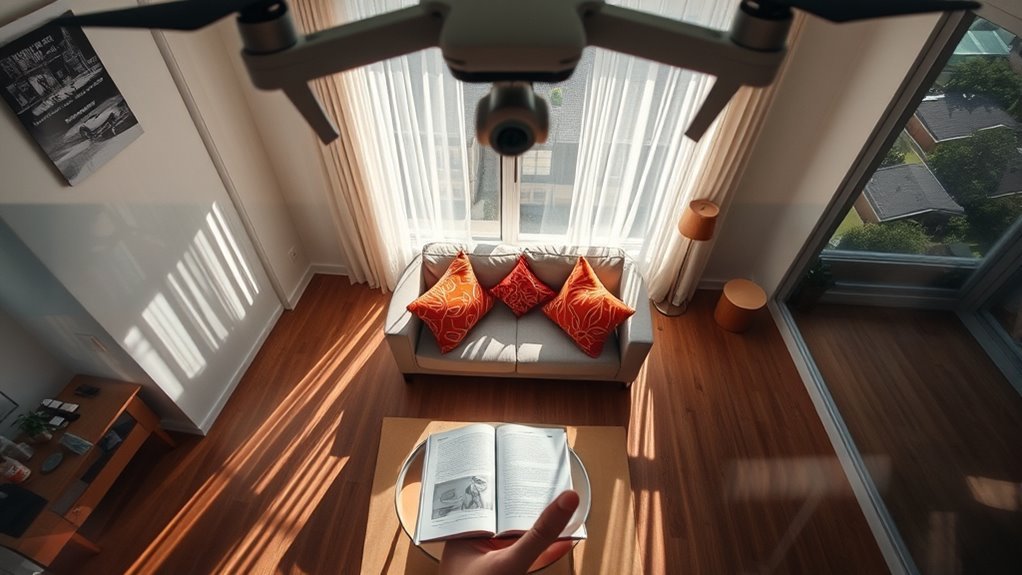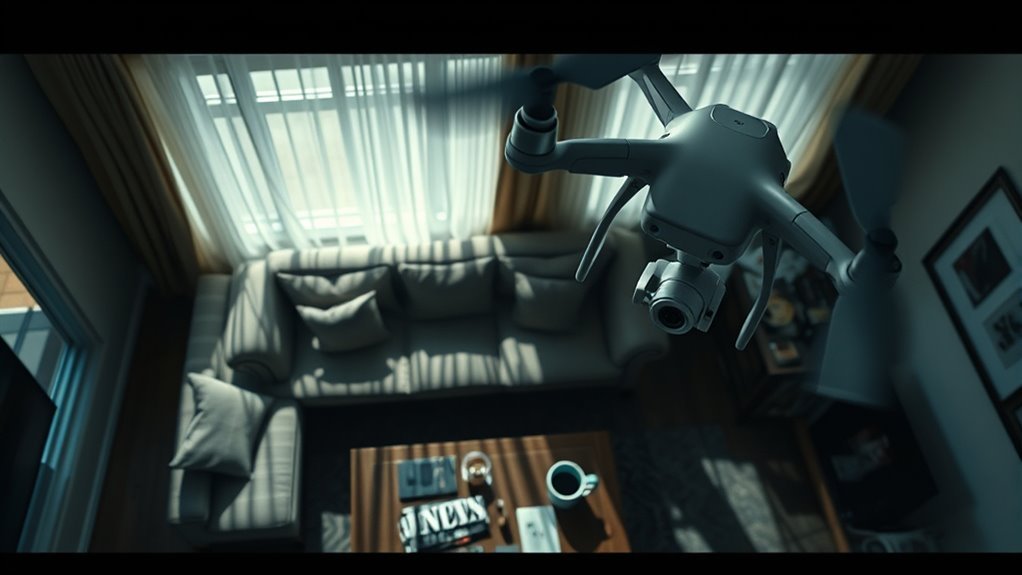Police drones can see inside your house using advanced technology like thermal imaging and high-resolution cameras. These tools allow them to detect heat signatures and capture images, potentially revealing activities within your home. While they provide law enforcement with valuable information, this raises significant privacy concerns. You might wonder about the legal implications of such surveillance. There’s a lot more to contemplate about the balance between safety and privacy in this evolving field.
Understanding Police Drone Technology

As you explore the world of police drone technology, you might wonder how these devices have transformed law enforcement practices. With various drone types—fixed-wing, quadcopters, and hybrid models—each offers unique advantages tailored for different scenarios. Technological advancements have propelled their capabilities, enabling real-time aerial surveillance and rapid deployment in emergencies. You may question how these innovations affect community safety and privacy. Drones can enhance situational awareness during incidents, but they also raise ethical considerations regarding surveillance and civil liberties. By analyzing the impact of these tools on law enforcement, you can better understand the balance between enhanced security and the preservation of individual freedoms. Drones that are equipped with real-time data collection can provide crucial insights into ongoing situations, potentially improving response strategies. Are these advancements a step forward or do they threaten your rights?
The Capabilities of Surveillance Drones

While you might think of drones primarily as tools for recreation or photography, their capabilities in surveillance have greatly reshaped law enforcement operations. These surveillance drones offer a level of aerial surveillance that can cover vast areas quickly and efficiently. Equipped with thermal imaging technology, they can detect heat signatures, revealing hidden activities or individuals even in complete darkness. This capability allows law enforcement to monitor situations without being intrusive, yet it raises questions about privacy and civil liberties. How does the balance between public safety and individual freedom play out when drones can peer into our lives? As you consider these advancements, it’s essential to think critically about the implications of such powerful technology in your community.
Legal Framework Governing Drone Surveillance

The rapid integration of drones into law enforcement raises significant questions about the legal framework that governs their use, particularly in surveillance. You might wonder how existing surveillance regulations align with your constitutional rights. Currently, the laws surrounding drone use are often a patchwork, with some states implementing strict guidelines while others have minimal oversight. This inconsistency can create confusion about what’s permissible. Are police drones infringing on your right to privacy? Courts are still grappling with this issue, balancing the need for public safety against individual freedoms. As technology evolves, it’s essential for lawmakers to clarify these regulations to protect citizens while allowing law enforcement to utilize drones effectively. How will this balance shape the future of surveillance?
Privacy Concerns: What Can Drones See?
What exactly can drones capture when they soar above our neighborhoods? The potential for surveillance raises significant drones privacy concerns. Equipped with advanced cameras, drones can see into backyards, through windows, and even inside homes, depending on their altitude. This capability poses ethical implications regarding your right to privacy.
| What Drones Can See | Privacy Concerns |
|---|---|
| Outdoor activities | Invasion of personal space |
| Interior layouts | Unconsented monitoring |
| License plates | Profiling and targeting |
| Public gatherings | Chilling effect on free expression |
As drones become more commonplace, it’s vital to reflect on how this technology impacts individual freedoms and the balance between safety and privacy.
Case Studies: Drones in Action
As drones increasingly integrate into various sectors, it’s intriguing to examine real-world applications that highlight their capabilities and limitations. In conducting a case analysis, you’ll find several compelling examples of drone efficiency:
- Search and Rescue Missions: Drones can quickly cover vast areas, locating missing persons faster than traditional methods.
- Traffic Monitoring: Law enforcement employs drones to assess real-time traffic conditions, improving response times during emergencies.
- Crime Scene Investigation: Drones provide aerial views of crime scenes, offering vital insights that ground-level officers might miss.
These cases illustrate how drones enhance operational effectiveness while also prompting questions about their potential drawbacks. As you explore these scenarios, consider how they shape the discourse around the use of drones in law enforcement and public safety. Additionally, the incorporation of advanced AI integration in drone technology could significantly enhance their operational efficiency and effectiveness in various applications.
The Balance Between Safety and Privacy
As police drones become more common, how do we weigh the benefits of enhanced community safety against our right to privacy? You might wonder about the legal implications of surveillance and where the line should be drawn. Is it possible to find a balance that respects individual freedoms while still ensuring public security?
Legal Implications of Surveillance
While the rise of police drones promises enhanced public safety and crime prevention, it also raises critical questions about privacy rights and the legal frameworks governing surveillance. You might wonder how we can balance these two important aspects.
Consider the following points about surveillance ethics:
- Informed Consent: Are individuals aware that they’re being surveilled, and do they have a say in it?
- Scope of Surveillance: What limitations should be set on the areas and situations where drones can operate?
- Accountability Mechanisms: How can we guarantee that misuse of surveillance technology is effectively monitored and penalized?
These questions highlight the delicate balance between guaranteeing safety and respecting personal freedoms. Understanding these implications is crucial as technology continues to evolve.
Community Safety vs. Privacy
The tension between community safety and privacy rights is increasingly apparent as police drones become more prevalent in law enforcement. On one hand, you might see the benefits of drones in addressing community concerns, such as crime prevention and rapid response to emergencies. However, do you ever wonder how far this surveillance can go? The use of drones raises critical questions about the erosion of privacy rights. Are you comfortable with law enforcement having the ability to monitor your activities from the sky? Balancing safety and privacy requires careful consideration of the implications of surveillance technology. It’s vital to engage in open dialogue about these issues to guarantee that while communities are safe, individual freedoms aren’t compromised.
Public Perception of Police Drones
How do you feel about the growing presence of police drones in your community? Public opinion seems divided, reflecting a mix of apprehension and acceptance. You might wonder how this technology impacts your rights and freedoms.
Consider these key points:
- Surveillance Concerns: Many fear that drones invade privacy and contribute to a surveillance state.
- Safety Benefits: Others argue drones enhance safety, aiding in crime prevention and rapid response.
- Societal Acceptance: Acceptance often hinges on transparency in how police use this technology.
As you weigh these perspectives, think about how increased police capabilities could affect community trust and individual liberties. Understanding drone regulations is essential as balancing safety with freedom remains a critical conversation as society navigates this evolving landscape.
Future of Drone Technology in Law Enforcement
As advancements in drone technology continue to emerge, you might find yourself questioning how these innovations will shape the future of law enforcement. Could autonomous operations reduce the need for human intervention, making policing more efficient yet potentially eroding accountability? As drones become smarter, equipped with advanced data analytics, they can analyze vast amounts of information in real-time, identifying patterns that may not be visible to officers on the ground. However, this raises concerns about privacy and civil liberties. Will society accept a future where drones monitor neighborhoods constantly? Balancing safety and freedom is vital. As you consider these implications, it’s important to engage in discussions about ethical use and regulatory frameworks to guarantee technology serves the public good without infringing on individual rights. Moreover, the integration of predictive analytics in drone operations can enhance their ability to forecast potential threats, further complicating the ethical landscape. Additionally, ensuring NDAA compliance will be crucial for maintaining trust and security in law enforcement applications of drone technology.
Frequently Asked Questions
Can Police Drones Capture Audio Inside Homes?
Could police drones record audio from inside homes? With advancements in audio surveillance, the potential raises significant privacy concerns. It’s essential to question how far technology should encroach upon our personal spaces and freedoms.
Are There Restrictions on Drone Flight Altitudes?
Are there restrictions on drone flight altitudes? Yes, drone flight regulations often impose altitude limitations to guarantee safety and privacy. It’s essential you understand these rules to navigate your freedoms responsibly while operating drones.
How Do Drones Differentiate Between Private and Public Property?
Drones often navigate the delicate dance of property rights, balancing legal boundaries and privacy invasions. You might wonder how they discern between private and public space—it’s a complex interplay of regulations and technology guiding their flight paths.
What Happens if a Drone Sees Illegal Activity Unintentionally?
If a drone captures unintentional evidence of illegal activity, what are the legal implications? You might find that this evidence can be admissible in court, raising questions about privacy rights versus public safety.
Can Homeowners Block Drone Surveillance Legally?
When it comes to drone privacy, you might feel like you’re fighting an uphill battle. In many places, legal protections exist to block unwarranted surveillance, but knowing your rights is essential. Are you prepared to defend them?

